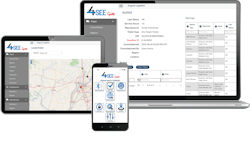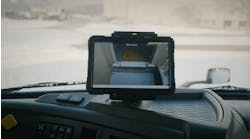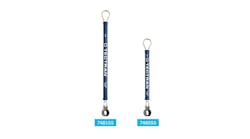Grote Industries unveiled the 4SEE smart trailer system, a combination of hardware and software that will enable truck fleets to have more access to data related to their operations and help improve safety on the roadways.
The 4SEE technology works by connecting the harness, nose box, and multiple sensors, creating data points for fleets to utilize. 4SEE hardwires all the components with a digital harness system that connects without grease and has a single connection point—the 4SEE nose box—to cab inputs. This allows a driver or fleet manager to have all outputs in one place.
“In today’s world, fleets need solutions that improve safety not only for the drivers, but also for the general roadways. They also need systems that are future-proof that can easily adapt to the latest technology. We understand those needs and have been working tirelessly to develop a system that is unique in its approach to addressing them,” John Grote, COO, said of the 4SEE development.The goal of the 4SEE system is to bring all the independent solutions together into one system, with a common communication stream, without increasing the harness or hardware required on the trailer. The 4SEE digital harness system also provides modules to connect legacy hardware and digital hardware to the same harness while isolating them to prevent one piece of the system from interfering with any other.
See also: Why telematics should extend from tractor to trailer
“When you think of the industry over the past 15 years, we’ve seen connected or telematics-equipped vehicles go from your light duty vehicles to your Class 8 tractors and now to this Class 8 trailer space. But there’s an evolution occurring in the space very much like the evolution in our own homes—interconnectivity,” explained CJ Biank, Grote's global market manager. “Trailers have long had a telematics system, ABS systems, weight and tire sensors… But now we’re seeing a need to reduce and streamline the data coming from those as much as possible. And we really see that coming through a smart connected trailer.
“We’ve spoken to our fleet customers; there’s one major issue common throughout: safety,” Biank emphasized. “We’ve heard it loud and clear… and we did not proceed into the smart connected trailer space without addressing those concerns.”
What is 4SEE?
The primary focus of the 4SEE system will be on increasing the safety of all trailers that leverage it. Additional value adds on the system will include security, efficiency, and reducing the TCO of such assets, Biank explained.
The 4SEE system integrates many of the same sensors seen on other systems available today; this includes tire pressure, load weight, radars, proximity sensors (sensing both interior and exterior), temperatures, operating hours, vibration, and more. The system collects all of this data and makes correlations between trailer performance and the data coming from such sensors.
The 4SEE system is currently being run by a number of fleets in road-trials. The road trials have been operating for ten months, with an accumulation of nearly 1 million road miles.
See also: Surviving the Wild West of smart trailers
The 4SEE smart nose box is pre-wired, meaning that there is no need to open the box to connect terminals. Present are two connectors—one to a traditional 7-way harness, and another to the 4SEE digital harness.
Wireless connectivity is built into the box, explained Dr. Adam Slade, director of engineering, as it contains internal radios for connection directly to mobile devices, as well as the back office.
The 4SEE nose box also contains an “easy-to-use” interface that can control the trailer and display critical trailer-health information. The box is also built to withstand any weather condition, protects against impact and water ingress, and can even face high-pressure washes.
“Telematics are built right into the 4SEE smart trailer nose box,” Slade continued. The box contains internal antennae to ensure connection, as well as a backup lithium-ion phosphate battery to provide up to 60 days of untethered conductivity.
“Any smart system is limited by how good its connectivity is,” Slade stated. “In the case of 4SEE, we’re leveraging the latest wireless technologies to connect the data generated within the trailer to the end user. A local wireless network is established using Bluetooth technologies. This allows direct interaction with the trailer using a mobile device. 4SEE utilizes an integrated latest generation cellular modem to connect to the wide area network. The 4SEE cloud provides APIs for partner access to our database.”Slade continued, noting that all system data is protected with full encryption the moment it leaves the trailer. In addition to API access for partner integration, 4SEE includes a mobile application for operators, maintenance crews, and OEM installers. In addition to the mobile application, 4SEE also includes a web portal for remote management and control of trailer assets from the back office.
Digital harness technology
The 4SEE system is designed to be modular and expandable. Users can simply plug in a new sensor or device to an existing connection point without disruption, or the need to run new wires or tear out existing installations.
The 4SEE digital harness itself has many advantages, as it takes the traditional seven conductor cable and reduces that to four conductors for data and power. “In so doing, the cable diameter is cut in half, and the weight of the cable drops by a factor of 10,” Slade said. “The 4SEE digital harness is smaller, more flexible, and easier to install and maintain.”The digital harness features four converter modules designed to adapt devices to the digital network: one for adapting smart devices which utilize digital communication, one for controlling proprietary lighting devices, one for analog sensors, and one for enabling any current trailer device to operate on the 4SEE network. This means that the 4SEE converter modules can integrate both proprietary and third-party devices into the 4SEE harness.
Trailer lighting advancements
When it comes to trailer lighting, 4SEE is compatible with traditional lighting as well as digitally controlled and customizable lamps. These lamps can monitor their own performance, provide feedback, and are multifunctional—as they can serve as strobe, beacon, backup, stop, turn, and tail lighting.
“As they are connected to data, they can react to their changing environment and leverage data from other sensors,” Slade furthered. “For example, they work in conjunction with our proximity sensors to indicate the distance to hazardous objects.” This is indicated through flashing and color-changing, he said.
See also: Trailer telematics: Beyond smart
Boosting operations and maintenance
The 4SEE smart trailer system will have a limited release in Q4 of this year, with a full release beginning in 2023. The 4SEE system will be available through the OEM spec’ing process, as well as a retrofit. Grote has established a retrofit network throughout North America capable of installing the system regardless of OEM. Furthermore, Grote can train maintenance personnel for fleets that wish to handle the install in-house. Depending on the trailer setup, installation can range anywhere from two to eight hours.
“A big piece of this is data and connecting systems,” Biank said. “The big piece of where we want to take this is really to those in-house maintenance teams. Taking this data and implementing it into their ordering systems so that as we see a system or a light beginning to fail, we can already have that replacement ordered in-house, in their inventory, ready to replace, to minimize the downtime. We look at accidents as number one, [whereas] downtime is a very close second to that and we want to minimize that as much as we can. How we use that data will definitely point us in that direction.”
The dry van offering is the initial MVP, or minimum viable product, that Grote is bringing to the market, Biank noted.
“Our intention is to take this to flatbeds and tankers. There is a robust roadmap that we developed,” he said. “There’s new functionality we’re working on, new integrations we’re working on, and all trailer types are in our future.”
This includes TRUs and the integration of the data coming from such systems as well, he concluded.







